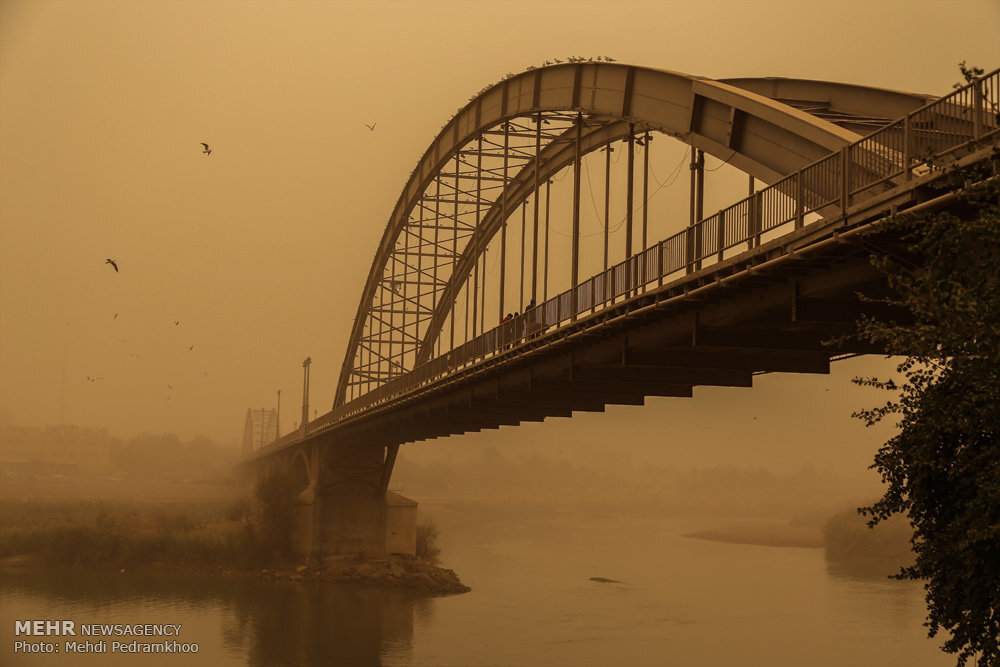Regional diplomacy to tackle SDSs

TEHRAN – An Iranian delegation, headed by Department of Environment chief Ali Salajegheh, has embarked on a trip to Iraq, Syria, and Kuwait to resolve the problem of sand and dust storms (SDSs).
The whole country has recently been haunted by the phenomenon of severe SDSs.
The purpose of this trip is to exchange views and consensus with the Iraqi authorities in the direction of collective cooperation in the region to deal with the phenomenon, field visits to SDS centers, and review effective and immediate solutions to reduce the effects.
In order to negotiate with neighboring countries to reduce the intensity of dust from foreign origins, Salajegheh expressed hope that by creating a regional convergence and alignment, appropriate achievements in combating dust will be achieved for the people.
Studies and maps show that Saudi Arabia produces the highest level of particulate matter, followed by Iraq, Syria, Kuwait, and the UAE, respectively, Salajegheh stated.
Turkmenistan, Uzbekistan, Afghanistan, Pakistan, Iraq, Syria, Saudi Arabia, and Jordan are the external sources of SDS.According to studies, the main centers of dust that affect our country in Iraq and Syria have been fully identified and mapped, so on the first trip we will go to Iraq and hold a meeting with the Iraqi government, he noted.
In the first phase, we are consulting on a bilateral and multilateral memorandum of understanding so that the main secretariat for dust management in West Asia can be established in Iran.
The third trip will probably be to Kuwait because Kuwait has announced its readiness to hold a joint meeting in this regard, he stated.
“We seek to create regional convergence between these countries because all of them have been so affected that Iraq, Kuwait, and the UAE are in a more unfavorable situation than our country,” he lamented.
In June, we will host a meeting of ambassadors of neighboring countries, and in July, we will host a meeting of environment ministers of 15 neighboring countries to conclude a strategy, he said.
The issue of SDSs has not arisen all at once and is due to the fact that we have taken nature for granted in the last hundred years, and the factors of climate change are exacerbating this situation, he added.
SDSs hotspots
The SDSs phenomenon has been plaguing the country for several years and has caused problems in many provinces. According to experts, natural and human factors are involved in the occurrence and severity of this phenomenon which is mainly caused by excessive consumption of water and drying up reservoirs.
Over the past two years, the precipitation rate has been on a downward trend, as a result, sources of sand and dust storms (SDSs) have increased compared to a year before, Ahad Vazifeh, head of the national center for drought and crisis management, has said.
Declining water levels in dams and lakes mean that water available to humans has been reduced and the dust-raising areas have been increased, he lamented, ISNA reported.
The internal dust sources are estimated at 34.6 million hectares, generating an average amount of 4.22 million tons of dust per year, about 1.460 million hectares are dried wetlands.
Some 4.23 million tons of dust are raised per year, which means the loss of soil fertility will hit the agricultural sector.
All the SDSs sources are not located in Iran, 300 million hectares in the neighboring countries are giving rise to SDSs, which transport dust into Iran. The total dust density is estimated at about 150 million tons.
In fact, the dust is raised from Turkmenistan, Uzbekistan, Afghanistan, and Pakistan in the northeast as well as Iraq, Syria, Saudi Arabia, and Jordan in the south, southwest, and west.
Enhanced diplomacy
Controlling sand and dust storms (SDSs) requires strengthening diplomacy, and it will never be eradicated unless international institutions reach a consensus.
Dariush Gol Alizadeh, Head of Iran's National Climate Change Office (NCCO) of the Department of Environment, told IRNA on Tuesday that the hotspots of the dust haunting the country in the last few days in eastern Syria, western Iraq, as well as Jordan, and Saudi Arabia.
These dust sources have appeared many years ago, and due to the drought and water shortages that have occurred in recent years, they have both intensified and increased in number. In fact, abandoned agricultural lands in those countries are a source of SDSs, he explained.
If serious action is not taken in the form of diplomacy and international institutions do not comply with the requirements to eradicate SDSs, the countries will always be haunted by the phenomenon, he lamented.
SDS not only affects people’s health but also has a psychological effect, it also has a great negative effect on agricultural products, and on the reproduction of plant species and activities such as beekeeping, he further noted.
At present, this phenomenon cannot be dealt with, but the damage can be minimized, he said, adding that programs to be carried out in this regard can be planting crops, shrubs, and finally soil stabilization by biological mulches.
FB/MG
